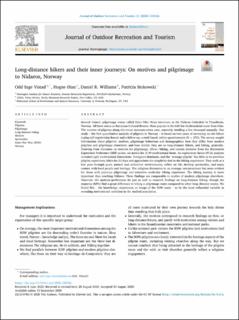| dc.contributor.author | Vistad, Odd Inge | |
| dc.contributor.author | Øian, Hogne | |
| dc.contributor.author | Williams, Daniel R. | |
| dc.contributor.author | Stokowski, Patricia | |
| dc.coverage.spatial | Gudbrandsdal route, Trondheim, Nidaros, Norge, Norway | en_US |
| dc.date.accessioned | 2020-10-23T11:01:48Z | |
| dc.date.available | 2020-10-23T11:01:48Z | |
| dc.date.created | 2020-09-16T12:35:37Z | |
| dc.date.issued | 2020 | |
| dc.identifier.issn | 2213-0780 | |
| dc.identifier.uri | https://hdl.handle.net/11250/2684749 | |
| dc.description.abstract | Several historic pilgrimage routes called Saint Olav Ways terminate at the Nidaros Cathedral in Trondheim, Norway. All have status as European Cultural Routes. Most popular is the 643 km Gudbrandsdal route from Oslo. The number of pilgrims along this route increases every year, currently totalling a few thousand annually. Our study – the first quantitative analysis of pilgrims in Norway – is based on two years of surveying on-site hikers (using self-registration boxes) and a follow-up, e-mail based, online questionnaire (N =276). The survey sought information about pilgrims’ motives, pilgrimage behaviour and demographics; how they differ from modern pilgrims and pilgrimage elsewhere; and how similar they are to long-distance hikers, and hiking, generally. Drawing from literature on motives for pilgrimage, (thru-) hiking, and certain domains from the Recreation Experience Preference (REP) scales, we used a list of 49 motivational items. An exploratory factor (PCA) analysis revealed eight motivational dimensions. Foreigners dominate, and the “average pilgrim” has little or no previous pilgrim experience, hikes for 22 days and appreciates the simplicity tied to the hiking experience. They walk at a low pace through quiet, natural and unfamiliar environments, reflect on life, develop spirituality, and enjoy contact with local people and heritage. The religious dimension is, on average, not prominent but more evident for those with previous pilgrimage and extensive multi-day hiking experience. The hiking journey is more important than reaching Nidaros. These findings are comparable to studies of modern pilgrimage elsewhere. However, the motives/preferences tie just as well to research findings on long-distance hiking, though the majority (68%) find a great difference in hiking a pilgrimage route compared to other long distance routes. We found this – the knowledge, experience, or image of the SOW route – to be the most influential variable in revealing motivational variation in the studied population. Pilgrims Pilgrimage Long-distance hiking Motives Spirituality Saint Olav Way (SOW) Norway | en_US |
| dc.language.iso | eng | en_US |
| dc.rights | Navngivelse 4.0 Internasjonal | * |
| dc.rights.uri | http://creativecommons.org/licenses/by/4.0/deed.no | * |
| dc.title | Long-distance hikers and their inner journeys: On motives and pilgrimage to Nidaros, Norway | en_US |
| dc.type | Peer reviewed | en_US |
| dc.type | Journal article | en_US |
| dc.description.version | publishedVersion | en_US |
| dc.rights.holder | © 2020 The Authors. | en_US |
| dc.subject.nsi | VDP::Samfunnsgeografi: 290 | en_US |
| dc.subject.nsi | VDP::Human geography: 290 | en_US |
| dc.subject.nsi | VDP::Samfunnsgeografi: 290 | en_US |
| dc.subject.nsi | VDP::Human geography: 290 | en_US |
| dc.source.volume | 31 | en_US |
| dc.source.journal | Journal of Outdoor Recreation and Tourism | en_US |
| dc.identifier.doi | 10.1016/j.jort.2020.100326 | |
| dc.identifier.cristin | 1830417 | |
| dc.relation.project | Norges forskningsråd: 243714 | en_US |
| dc.source.articlenumber | 100326 | en_US |
| cristin.ispublished | true | |
| cristin.fulltext | original | |
| cristin.qualitycode | 1 | |

